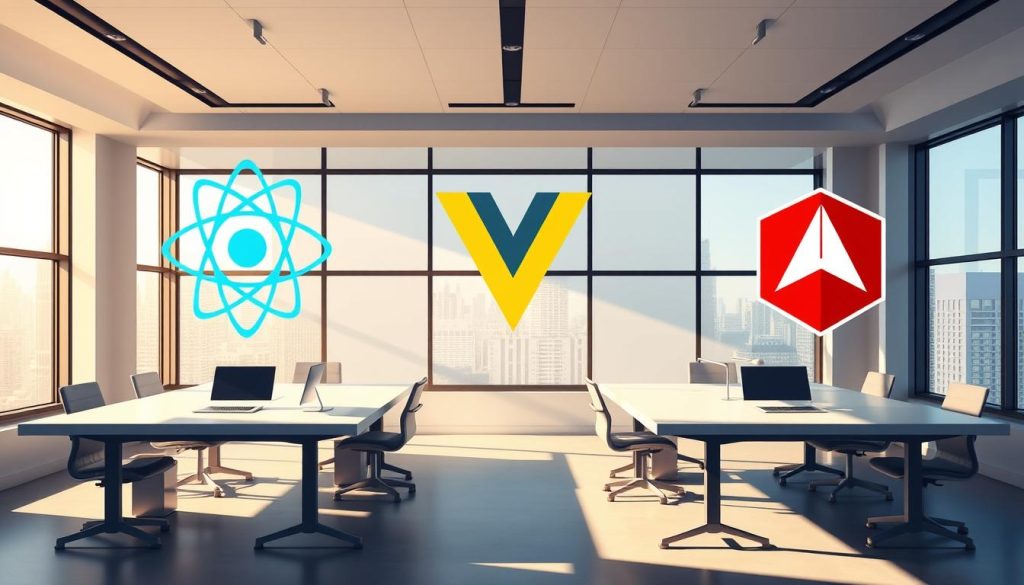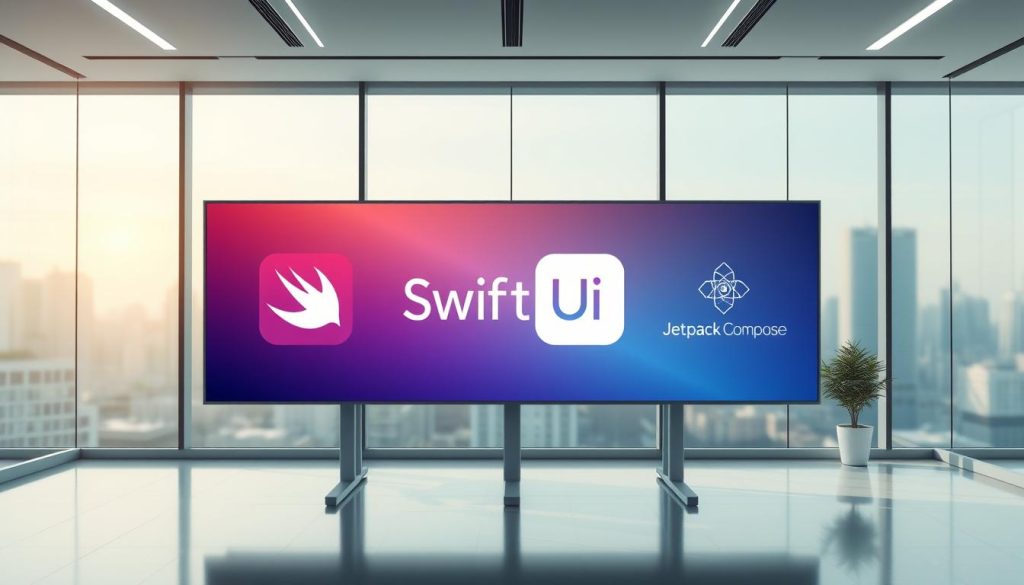Kotlin Multiplatform vs Flutter: The Future of Cross-Platform
Cross-platform development has revolutionized the way applications are built, allowing developers to create apps that run seamlessly across multiple platforms from a single codebase.
This approach has gained immense popularity due to its efficiency and cost-effectiveness. Two prominent frameworks have emerged as leaders in this space: Kotlin Multiplatform and Flutter.

As the demand for cross-platform apps continues to grow, understanding the strengths and weaknesses of these frameworks is crucial for developers and businesses alike.
Key Takeaways
- Overview of cross-platform development benefits
- Introduction to Kotlin Multiplatform and Flutter
- Importance of choosing the right framework
- Comparison basis for the two frameworks
- Future implications for cross-platform development
The State of Cross-Platform Development in 2025
The year 2025 marks a pivotal moment in the evolution of cross-platform development, with native-like solutions gaining prominence. This shift is driven by the need for businesses to deliver high-performance applications across multiple platforms without compromising on user experience.
Evolution from Web-Based to Native-Like Solutions
Cross-platform development has evolved significantly from its early days of web-based solutions. Modern frameworks now offer native-like performance, bridging the gap between cross-platform and native app development. Recent statistics show that over 70% of businesses are adopting cross-platform frameworks to streamline their app development processes.
Business Drivers Behind Cross-Platform Adoption
The adoption of cross-platform development is driven by several business factors, including reduced development costs, faster time-to-market, and the ability to maintain a single codebase across multiple platforms. Companies are leveraging these frameworks to enhance their competitive edge by delivering high-quality apps more efficiently.
Key Metrics for Evaluating Cross-Platform Frameworks
When evaluating cross-platform frameworks, businesses consider several key metrics, including performance, ease of development, community support, and compatibility with various platforms. A robust framework should offer a balance between these factors to meet the diverse needs of businesses.
By understanding these aspects, businesses can make informed decisions about adopting cross-platform development solutions that align with their strategic goals.
Kotlin Multiplatform: Architecture and Core Principles
The architecture of Kotlin Multiplatform is designed to maximize code sharing across different platforms, enabling developers to maintain a single codebase for multiple operating systems.
The “Share What You Can” Philosophy
Kotlin Multiplatform embodies the “Share What You Can” philosophy, allowing developers to share code where it makes sense, while still permitting platform-specific implementations when necessary. This approach provides the flexibility to optimize performance and user experience on each platform.
As Roman Elizarov, Kotlin’s language designer, once noted, “Kotlin Multiplatform is not about sharing 100% of the code, but about sharing what’s feasible and maintaining platform-specific code where needed.” This philosophy is central to KMP’s design.
Kotlin’s Multi-Platform Project Structure
A typical Kotlin Multiplatform project is structured into several modules, including common code, platform-specific code, and tests. The common module contains code that can be shared across platforms, while platform-specific modules handle unique implementations.
| Module Type | Description |
|---|---|
| Common | Shared code across platforms |
| Platform-Specific | Unique implementations for each platform |
| Tests | Module-specific and common tests |
JetBrains’ Strategic Vision and Roadmap
JetBrains, the creators of Kotlin, continue to evolve Kotlin Multiplatform, with a focus on improving code sharing capabilities and expanding platform support. Their strategic vision includes enhancing interoperability with other development frameworks and tools.
As Kotlin Multiplatform continues to mature, it is poised to become an even more powerful tool for cross-platform development, offering developers a flexible and efficient way to build multi-platform applications.
Flutter: Google’s UI Toolkit Approach
As a versatile UI toolkit, Flutter empowers developers to craft beautiful, natively compiled applications. This capability is rooted in its robust architecture and feature set, which we’ll explore in detail.
Dart Language Fundamentals
Flutter is built around the Dart language, which is designed to be fast, efficient, and easy to learn. Dart’s just-in-time (JIT) compilation enables rapid development with features like hot reload, while its ahead-of-time (AOT) compilation ensures that apps run smoothly on various platforms.
Dart’s syntax is concise and readable, making it accessible to developers familiar with other programming languages. Its async/await syntax simplifies asynchronous programming, a crucial aspect of modern app development.
The Widget-Based Rendering Engine
At the heart of Flutter’s UI capabilities is its widget-based rendering engine. This engine allows for the creation of complex, customizable UI components. Flutter’s widget tree is a hierarchical structure that efficiently manages the UI elements, enabling seamless rendering and updates.
Flutter’s “Everything is a Widget” Paradigm
In Flutter, everything is indeed a widget. This paradigm simplifies the development process by providing a uniform way to handle UI elements. From basic components like buttons and text fields to complex layouts, all are treated as widgets.
| Widget Type | Description | Example |
|---|---|---|
| Stateless Widgets | Immutable widgets that cannot change once built | Icon, Text |
| Stateful Widgets | Mutable widgets that can change during runtime | Checkbox, Slider |
| Layout Widgets | Widgets that control the arrangement of other widgets | Row, Column |
This widget-based approach not only streamlines UI development but also promotes code reusability and maintainability. By understanding and leveraging Flutter’s UI toolkit, developers can create high-quality, engaging applications across multiple platforms.
Technical Architecture Comparison
A comprehensive comparison of Kotlin Multiplatform and Flutter’s technical architectures reveals key differences in their design principles and implementation strategies. This analysis is crucial for developers and businesses aiming to leverage the most suitable framework for their cross-platform development needs.
Code Sharing Strategies: KMP vs Flutter
Kotlin Multiplatform (KMP) and Flutter adopt different approaches to code sharing. KMP allows developers to share code between platforms while still enabling platform-specific implementations where necessary. This is achieved through its “expect/actual” mechanism, which facilitates sharing of logic while allowing for native UI and platform-specific code.
Flutter, on the other hand, uses a single codebase written in Dart, which is then compiled to native code for the target platforms. Flutter’s widget-based architecture ensures a consistent UI across platforms, but it may require additional effort for platform-specific customizations.
Compilation Process and Platform Integration
The compilation process differs significantly between KMP and Flutter. KMP compiles Kotlin code to the target platform’s native format, ensuring seamless integration with the platform’s ecosystem. Flutter compiles Dart code into native ARM code, using its rendering engine to handle UI components.
Threading Models and Concurrency Patterns
Threading and concurrency are handled differently by the two frameworks. KMP leverages the threading models of the target platforms, allowing for native concurrency patterns. Flutter uses its own concurrency model, isolating tasks into separate isolates to avoid shared state complexities.
Memory Management Differences
Memory management is another area where KMP and Flutter diverge. KMP relies on the garbage collection mechanisms of the Kotlin compiler for the JVM and native memory management for other platforms. Flutter uses Dart’s garbage collector, which is designed to handle the demands of a reactive framework.
Understanding these technical differences is crucial for selecting the right framework for your project. While KMP offers more flexibility in terms of code sharing and native integration, Flutter provides a robust, unified development experience with its widget-based architecture.
Performance Benchmarks and Real-World Metrics
When evaluating Kotlin Multiplatform and Flutter, performance benchmarks play a crucial role in determining the best framework for your project. Both frameworks have made significant strides in optimizing performance, but there are key differences that can impact your application’s efficiency and user experience.
Application Size and Resource Consumption
Application size and resource consumption are critical factors in mobile app development. Kotlin Multiplatform allows for more flexibility in terms of resource management, as it can leverage native platform APIs directly. In contrast, Flutter uses its own rendering engine, which can result in larger application sizes due to the inclusion of the Flutter engine.
Recent benchmarking studies have shown that Flutter applications tend to be larger in size compared to their Kotlin Multiplatform counterparts. However, the difference is often negligible, and Flutter’s tree-shaking capabilities can help reduce the overall size.
Rendering Speed and UI Smoothness
Rendering speed and UI smoothness are essential for providing a seamless user experience. Flutter’s rendering engine is designed to provide consistent, high-performance rendering across different platforms. Kotlin Multiplatform, on the other hand, relies on the native UI components of each platform, which can result in optimal rendering performance.
- Flutter’s rendering engine provides consistent performance across platforms.
- Kotlin Multiplatform leverages native UI components for optimal performance.
Cold Start and Runtime Performance
Cold start times and runtime performance are critical metrics for evaluating the overall performance of an application. Cold start times for Flutter applications can be slightly longer due to the initialization of the Flutter engine. However, once the application is running, both frameworks can provide smooth and responsive performance.
Platform-Specific Performance Variations
It’s essential to consider platform-specific performance variations when evaluating Kotlin Multiplatform and Flutter. For instance, Kotlin Multiplatform may exhibit different performance characteristics on Android versus iOS due to the underlying platform architectures.
- Android and iOS have different platform architectures that can impact performance.
- Kotlin Multiplatform and Flutter handle platform-specific performance optimizations differently.
User Interface Development Capabilities
Delivering a native-like user experience is critical, and both Kotlin Multiplatform and Flutter provide robust solutions for UI development. When evaluating these frameworks, it’s essential to consider their approaches to user interface creation.
Flutter’s Material and Cupertino Design Systems
Flutter stands out with its comprehensive design systems, including Material Design for Android and Cupertino for iOS. These systems enable developers to create visually appealing and platform-consistent UIs. For instance, apps like Alibaba and Google Ads have successfully utilized Flutter’s design capabilities to deliver high-quality user experiences.

Kotlin Multiplatform’s Platform-Specific UI Approach
Kotlin Multiplatform, on the other hand, adopts a platform-specific UI approach. It allows developers to use native UI components for each platform, ensuring a truly native look and feel. This approach is beneficial for complex, custom UI requirements.
Animation and Interactive Elements
Both frameworks support the creation of engaging animations and interactive elements. Flutter’s widget-based architecture makes it particularly straightforward to implement complex animations. Kotlin Multiplatform can leverage the native animation APIs of the platforms it targets.
Accessibility and Internationalization Support
Accessibility is a critical aspect of UI development. Flutter provides built-in support for accessibility features, making it easier to develop apps that are usable by everyone. Kotlin Multiplatform can also achieve high accessibility standards by utilizing the native accessibility APIs. Furthermore, both frameworks support internationalization, enabling developers to create apps that cater to a global audience.
In conclusion, both Kotlin Multiplatform and Flutter offer powerful UI development capabilities, each with its strengths. The choice between them depends on the specific needs of the project, including the desired level of native integration and the complexity of the UI requirements.
Developer Experience and Learning Curve
The success of cross-platform development frameworks hinges on their developer experience and learning curve. Both Kotlin Multiplatform and Flutter have garnered significant attention, but their approach to enhancing developer experience differs.
Required Technical Background and Skills
Kotlin Multiplatform requires a strong background in Kotlin programming and familiarity with native development for the target platforms. In contrast, Flutter demands proficiency in Dart and its widget-based UI paradigm. Developers already invested in the Kotlin ecosystem may find KMP more approachable, while those looking for a more UI-centric framework might prefer Flutter.
IDE Support and Development Tooling
Flutter benefits from comprehensive IDE support through Android Studio and Visual Studio Code, with extensive plugins for debugging and widget inspection. Kotlin Multiplatform also enjoys robust support in IntelliJ IDEA and Android Studio, leveraging the mature Kotlin tooling. Effective IDE support significantly reduces the learning curve for both frameworks.
Hot Reload and Development Iteration Speed
Both frameworks offer hot reload capabilities, enhancing development speed. Flutter’s hot reload is particularly renowned for its seamless UI updates, while Kotlin Multiplatform’s hot reload is improving with recent updates. Faster iteration cycles directly impact developer productivity.
Testing Frameworks and Debugging Tools
Testing and debugging are crucial aspects of the developer experience. Flutter provides a comprehensive testing framework and robust debugging tools, including the Flutter Inspector. Kotlin Multiplatform, while leveraging Kotlin’s testing capabilities, requires additional setup for native platform testing. The table below summarizes key differences:
| Feature | Kotlin Multiplatform | Flutter |
|---|---|---|
| Primary Language | Kotlin | Dart |
| Hot Reload | Available, improving | Robust, with UI updates |
| IDE Support | IntelliJ, Android Studio | Android Studio, VS Code |
Understanding these differences is key to choosing the right framework for your project, balancing the need for rapid development, ease of learning, and overall developer experience.
Native Code Integration and Platform Access
Native code integration is a key factor in determining the performance and capabilities of cross-platform frameworks like Kotlin Multiplatform and Flutter. As developers seek to leverage platform-specific features while maintaining a shared codebase, the effectiveness of native integration becomes crucial.
Flutter’s Platform Channels and Plugin System
Flutter achieves native code integration through its platform channels and plugin system. This allows developers to invoke native APIs and access platform-specific features. For instance, when a Flutter app needs to access device hardware like the camera or GPS, developers can use platform channels to communicate with the native code.
Example of Flutter’s Platform Channel:
MethodChannel(‘com.example.flutterapp/camera’)
.invokeMethod(‘takePicture’)
.then((result) => print(‘Picture taken: $result’))
.catchError((error) => print(‘Error: $error’));
Kotlin Multiplatform’s Expect/Actual Mechanism
Kotlin Multiplatform (KMP) employs the expect/actual mechanism for native code integration. This involves declaring expected functions or classes in the common code and providing actual implementations for each platform. This approach allows for seamless integration of native code while maintaining a shared Kotlin codebase.
Example of KMP’s Expect/Actual Mechanism:
// Common code
expect fun getPlatformName(): String
// Android actual implementation
actual fun getPlatformName(): String = “Android”
// iOS actual implementation
actual fun getPlatformName(): String = “iOS”
Handling Platform-Specific Features and APIs
Both frameworks require careful handling of platform-specific features and APIs. For Flutter, this involves using platform channels and plugins, while KMP relies on the expect/actual mechanism. The choice between these approaches depends on the project’s specific needs and the development team’s expertise.
Performance Implications of Native Bridging
Native bridging can have significant performance implications. In Flutter, frequent use of platform channels can lead to performance overhead due to the asynchronous nature of the communication. Similarly, in KMP, the expect/actual mechanism, while generally efficient, can introduce complexity and potential performance issues if not managed carefully.
| Aspect | Flutter | Kotlin Multiplatform |
|---|---|---|
| Native Integration Mechanism | Platform Channels and Plugins | Expect/Actual Mechanism |
| Performance Implications | Asynchronous communication overhead | Potential complexity and performance issues if not managed carefully |
As highlighted by JetBrains, “Kotlin Multiplatform allows you to keep the best of both worlds: a shared codebase for business logic and native code for platform-specific features.” This underscores the importance of choosing the right approach based on project requirements.

Real-World Applications and Success Stories
As cross-platform development continues to gain traction, real-world applications and success stories are emerging that showcase the potential of Kotlin Multiplatform and Flutter. Both frameworks have been adopted by major companies and have delivered impressive results in various industries.
Major Apps Built with Flutter
Flutter has been used to build several high-profile applications, including Google Ads, Alibaba, and BMW. These apps demonstrate Flutter’s capability in handling complex UI requirements and delivering high-performance experiences. For instance, Google Ads saw a 20% increase in user engagement after adopting Flutter.
Enterprise Adoption of Kotlin Multiplatform
Kotlin Multiplatform has been gaining traction among enterprises due to its ability to share code across multiple platforms while maintaining native performance. Companies like JetBrains, Cash App, and Philips have successfully adopted KMP for their projects. For example, Cash App reported a significant reduction in development time and improved maintainability after implementing KMP.
Industry-Specific Implementation Considerations
Different industries have unique requirements that can affect the choice between Kotlin Multiplatform and Flutter. For instance, in the finance sector, security and compliance are paramount, while in e-commerce, UI/UX and performance are critical. Understanding these industry-specific needs is crucial for successful implementation.
Migration Stories and Lessons Learned
Several companies have shared their migration stories and lessons learned when transitioning to Kotlin Multiplatform or Flutter. A common theme among these stories is the importance of careful planning and assessment of the existing codebase and the goals of the migration project. Companies like Square have documented their experiences, providing valuable insights for others considering a similar path.
Kotlin Multiplatform vs Flutter: The Future of Cross-Platform (2025)
As we approach 2025, the landscape of cross-platform development is poised for significant transformations. The ongoing evolution of frameworks like Kotlin Multiplatform and Flutter will be shaped by emerging trends, technological advancements, and changing market demands.
Emerging Trends in Framework Evolution
Both Kotlin Multiplatform and Flutter are expected to continue their rapid evolution. Kotlin Multiplatform is likely to see enhancements in its interoperability features, making it easier for developers to share code across different platforms. Meanwhile, Flutter is anticipated to further improve its UI capabilities, potentially incorporating more advanced graphics and animation features.
- Enhanced interoperability for Kotlin Multiplatform
- Advanced UI capabilities for Flutter
- Increased focus on developer productivity and tooling
Impact of WebAssembly and New Web Standards
The rise of WebAssembly (WASM) is set to significantly impact cross-platform development. Both frameworks are likely to adopt WASM to improve web support, enabling more seamless integration with web technologies. This could lead to new opportunities for developing complex web applications using these frameworks.
Predicted Market Share and Enterprise Adoption
By 2025, we can expect to see a significant shift in market share between Kotlin Multiplatform and Flutter. Enterprise adoption will play a crucial role in this shift, with companies increasingly looking for frameworks that offer robust support, scalability, and security.
Integration with AI and Cloud-Native Technologies
The integration of AI and cloud-native technologies will be a key trend. Both frameworks are likely to incorporate features that support AI-driven development, such as machine learning model integration and cloud-based services. This will enable developers to build more sophisticated, data-driven applications.
In conclusion, the future of cross-platform development with Kotlin Multiplatform and Flutter looks promising, driven by emerging trends, technological advancements, and the evolving needs of developers and enterprises.
Conclusion: Making the Strategic Choice for Your Project
When deciding between Kotlin Multiplatform and Flutter, consider your project’s specific needs and your team’s expertise. Both frameworks have their strengths, with Kotlin Multiplatform offering a “share what you can” approach that allows for native UI and platform-specific features, while Flutter provides a comprehensive UI toolkit with a single codebase.
The strategic choice depends on project considerations such as performance requirements, development time, and the need for native integration. Evaluate your priorities: if native UI and platform-specific features are crucial, Kotlin Multiplatform might be the better choice. For projects requiring a unified UI across platforms, Flutter’s widget-based approach could be more suitable.
Ultimately, the decision should be based on a thorough analysis of your project’s requirements and your team’s capabilities. By understanding the strengths and limitations of each framework, you can make an informed strategic choice that aligns with your project’s goals.
FAQ
What is Kotlin Multiplatform?
Kotlin Multiplatform is a technology that allows developers to share code between multiple platforms, including Android, iOS, desktop, and web, while still allowing for platform-specific code when needed.
What is Flutter?
Flutter is an open-source UI software development kit created by Google that allows developers to build natively compiled applications for mobile, web, and desktop from a single codebase.
How does Kotlin Multiplatform handle UI development?
Kotlin Multiplatform uses a platform-specific UI approach, meaning that developers write UI code specific to each platform (e.g., Android, iOS) while sharing business logic and other non-UI code.
What is the “everything is a widget” paradigm in Flutter?
In Flutter, everything is a widget because the framework is built around a widget-based rendering engine, where even the app itself is considered a widget, allowing for a highly customizable and flexible UI.
How do Kotlin Multiplatform and Flutter compare in terms of performance?
Both Kotlin Multiplatform and Flutter offer competitive performance, with Kotlin Multiplatform leveraging native code for performance-critical components and Flutter using its own rendering engine to achieve native-like performance.
What are the key differences in code sharing between Kotlin Multiplatform and Flutter?
Kotlin Multiplatform allows for sharing code between platforms at the business logic level, while Flutter shares code across platforms for both UI and business logic, using the Dart language.
Can I use native code with Kotlin Multiplatform and Flutter?
Yes, both frameworks allow for native code integration. Kotlin Multiplatform uses the expect/actual mechanism, while Flutter uses platform channels to interact with native code.
How do Kotlin Multiplatform and Flutter handle threading and concurrency?
Kotlin Multiplatform leverages the threading models of the target platforms, while Flutter uses its own concurrency model based on isolates, which are separate heaps that do not share memory.
What are the implications of using Kotlin Multiplatform vs Flutter for my project?
The choice between Kotlin Multiplatform and Flutter depends on your project’s specific needs, such as the level of code sharing required, the complexity of the UI, and the desired development speed.
Are there any notable applications or enterprises using Kotlin Multiplatform or Flutter?
Yes, several major applications and enterprises have adopted both Kotlin Multiplatform and Flutter, including companies like Google, Alibaba, and others, showcasing the viability and scalability of both frameworks.
What is the future outlook for Kotlin Multiplatform and Flutter?
Both frameworks are expected to continue evolving, with emerging trends like WebAssembly and AI integration likely to influence their development, potentially leading to increased adoption and new use cases.
How do I decide between Kotlin Multiplatform and Flutter for my cross-platform development needs?
The decision should be based on factors like your team’s expertise, the project’s requirements for code sharing, UI complexity, and performance needs, as well as considering the trade-offs between the two frameworks.

















